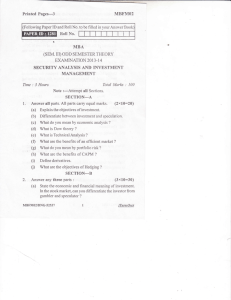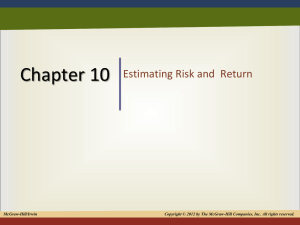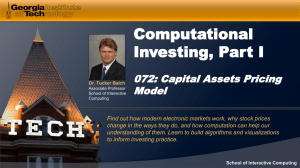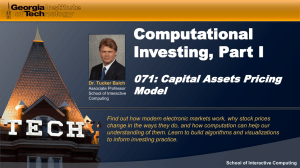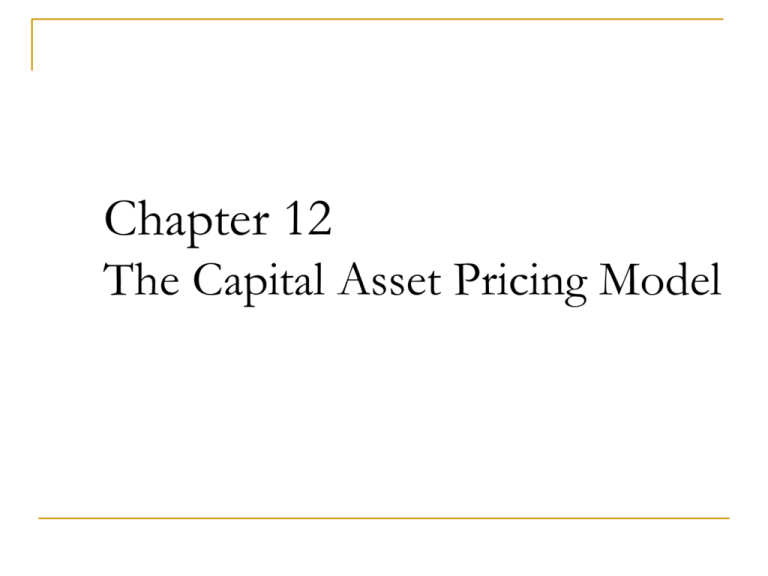
Chapter 12
The Capital Asset Pricing Model
Chapter Outline
12.1 The Efficiency of the Market Portfolio
12.2 Determining the Risk Premium
12.3 The Market Portfolio
12.4 Determining Beta
12.5 Extending the CAPM
12.6 The CAPM in Practice
12-2
Learning Objectives
1.
List the three main assumptions underlying the Capital
Asset Pricing Model.
2.
Explain why the CAPM implies that the market portfolio
of all risky securities is the efficient portfolio.
3.
Compare and contrast the capital market line with the
security market line.
4.
Define beta for an individual stock and for a portfolio.
5.
Define alpha, discuss implications of the CAPM for
alpha, and discuss the implications if alpha is not zero.
12-3
Learning Objectives
6.
Discuss the appropriate market index to use as a proxy
for the market portfolio.
7.
Explain how alpha is computed, and discuss its
persistence over time.
8.
Discuss the drawbacks of using historical data to
calculate parameters of the CAPM.
9.
Describe the results of relaxing the assumptions of the
CAPM; in particular, the assumptions that investors can
borrow and lend at the risk-free rate, the assumption
that investors have homogeneous expectations, and
the assumption that the market portfolio is efficient.
12-4
12.1 The Efficiency of the Market
Portfolio
Market Portfolio
The portfolio of all stocks and securities in the
market
E [Ri ] ri rf
eff
i
(E [Reff ] rf )
The expected return of any traded security is
determined by its beta with the efficient portfolio.
12-5
The CAPM Assumptions
Three Main Assumptions
Assumption 1
Investors can buy and sell all securities at competitive
market prices (without incurring taxes or transactions
costs) and can borrow and lend at the risk-free interest
rate.
12-6
The CAPM Assumptions (cont'd)
Three Main Assumptions
Assumption 2
Investors hold only efficient portfolios of traded
securities—portfolios that yield the maximum
expected return for a given level of volatility.
12-7
The CAPM Assumptions (cont'd)
Three Main Assumptions
Assumption 3
Investors have homogeneous expectations regarding
the volatilities, correlations, and expected returns of
securities.
Homogeneous Expectations
All investors have the same estimates concerning future
investments and returns.
12-8
Security Demand Must Equal Supply
Given homogeneous expectations, all investors will
demand the same efficient portfolio of
risky securities.
The combined portfolio of risky securities of all investors
must equal the efficient portfolio.
Thus, if all investors demand the efficient portfolio, and
the supply of securities is the market portfolio, the
demand for market portfolio must equal the supply of the
market portfolio.
12-9
Example 12.1
12-10
Example 12.1 (cont'd)
12-11
Optimal Investing: The Capital Market
Line
When the CAPM assumptions hold, an
optimal portfolio is a combination of the riskfree investment and the market portfolio.
When the tangent line goes through the market
portfolio, it is called the capital market line (CML).
12-12
Optimal Investing:
The Capital Market Line (cont'd)
The expected return and volatility of a capital
market line portfolio are:
E [RxCML ] (1 x)rf xE[RMkt ] rf x(E [RMkt ] rf )
SD(RxCML ) xSD(RMkt )
12-13
Figure 12.1 The Capital Market Line
12-14
Example 12.2
12-15
Example
12.2 (cont'd)
12-16
Figure 12.2 The Capital Market Line Offers the Best
Possible Risk–Return Combinations
12-17
12.2 Determining the Risk Premium
Market Risk and Beta
Given an efficient market portfolio, the expected
return of an investment is:
E[Ri ] ri rf iMkt (E[RMkt ] rf )
Risk premium for security i
The beta is defined as:
Volatility of i that is common with the market
Mkt
i
i
SD(Ri ) Corr (Ri ,RMkt )
SD(RMkt )
Cov(Ri ,RMkt )
Var (RMkt )
12-18
Example 12.3
12-19
Example 12.3 (cont'd)
12-20
Example 12.4
12-21
Example 12.4 (cont'd)
12-22
Alternative Example 12.4
Problem
Assume the risk-free return is 5% and the market
portfolio has an expected return of 12% and a
standard deviation of 44%.
ATP Oil and Gas has a standard deviation of 68%
and a correlation with the market of 0.91.
What is ATP’s beta with the market?
Under the CAPM assumptions, what is its
expected return?
12-23
Alternative Example 12.4
Solution
SD(Ri ) Corr (Ri ,RMkt ) (.68)(.91)
i
1.41
SD(RMkt )
.44
E[Ri ] rf iMkt (E[RMkt ] rf ) 5% 1.41(12% 5%) 14.87%
12-24
The Security Market Line
There is a linear relationship between a
stock’s beta and its expected return (See
figure on next slide). The security market
line (SML) is graphed as the line through the
risk-free investment and the market.
According to the CAPM, if the expected return and
beta for individual securities are plotted, they
should all fall along the SML.
12-25
Figure 12.3 The Capital Market Line
and the Security Market Line
12-26
Figure 12.3 The Capital Market Line
and the Security Market Line, panel (a)
12-27
Figure 12.3 The Capital Market Line
and the Security Market Line, panel (b)
12-28
Example 12.5
12-29
Example 12.5 (cont'd)
12-30
The Security Market Line (cont'd)
P
The beta of a portfolio is the weighted
average beta of the securities in the portfolio.
Cov i xi Ri ,RMkt
Cov(RP ,RMkt )
Var (RMkt )
Var (RMkt )
Cov(Ri ,RMkt )
i xi
Var (RMkt )
x
i
i
12-31
i
Example 12.6
12-32
Example 12.6
12-33
Alternative Example 12.6
Problem
Suppose the stock of the 3M Company (MMM)
has a beta of 0.69 and the beta of HewlettPackard Co. (HPQ) stock is 1.77.
Assume the risk-free interest rate is 5% and the
expected return of the market portfolio is 12%.
What is the expected return of a portfolio of
40% of 3M stock and 60% Hewlett-Packard
stock, according to the CAPM?
12-34
Alternative Example 12.6
Solution
P i xi i (.40)(0.69) (.60)(1.77) 1.338
E[Ri ] rf
Mkt
i
(E[RPortfolio ] rf )
E[Ri ] 5% 1.338(12% 5%) 14.37%
12-35
Alpha
To improve the performance of their portfolios,
investors will compare the expected return of
a security with its required return from the
security market line.
12-36
Alpha (cont'd)
The difference between a stock’s expected
return and its required return according to the
security market line is called the stock’s alpha.
s E[Rs ] rs E[Rs ] (rf s (E[RMkt ] rf ))
When the market portfolio is efficient, all
stocks are on the security market line and
have an alpha of zero.
12-37
Alpha (cont'd)
When the market portfolio is efficient, all
stocks are on the security market line and
have an alpha of zero.
Investors can improve the performance of
their portfolios by buying stocks with positive
alphas and by selling stocks with negative
alphas.
12-38
Figure 12.4 An Inefficient Market
Portfolio
12-39
Figure 12.5 Deviations from the
Security Market Line
12-40
Summary of the Capital Asset
Pricing Model
The market portfolio is the efficient portfolio.
The risk premium for any security is
proportional to its beta with the market.
12-41
12.3 The Market Portfolio
Market Capitalization
The total market value of a firm’s outstanding
shares
MVi (Number of Shares of i Outstanding) (Price of i per Share) Ni Pi
12-42
Value-Weighted Portfolios
Value-Weighted Portfolio
A portfolio in which each security is held in
proportion to its market capitalization
Market Value of i
xi
Total Market Value of All Securities
MVi
j MV j
12-43
Example 12.7
12-44
Example 12.7 (cont'd)
12-45
Value-Weighted Portfolios (cont'd)
A value-weighted portfolio is an equalownership portfolio; it contains an equal
fraction of the total number of shares
outstanding of each security in the portfolio.
Passive Portfolio
A portfolio that is not rebalanced in response to
price changes
12-46
Example 12.8
12-47
Example
12.8
(cont'd)
12-48
Common Stock Market Indexes
Market Index
The market value of a broad-based portfolio
of securities
Price-Weighted Portfolio
A portfolio that holds an equal number of shares
of each stock, independent of their size
12-49
Common Stock Market Indexes
(cont'd)
Example of a Price-Weighted Index
DJIA
Example of a Value-Weighted Index
S&P 500
Wilshire 5000
12-50
Common Stock Market Indexes
(cont'd)
Index Funds
Mutual funds that invest in stocks in proportion to
their representation in a published index
Exchange Traded Fund (ETF)
A security that trades directly on an exchange, like
a stock, but represents ownership in a portfolio of
stocks
12-51
Common Stock Market Indexes
(cont'd)
Market Proxy
A portfolio whose return closely tracks the true
market portfolio
12-52
12.4 Determining Beta
Estimating Beta from Historical Returns
Recall, beta is the expected percent change in the
excess return of the security for a 1% change in
the excess return of the market portfolio.
Consider Cisco Systems stock and how it
changes with the market portfolio.
12-53
Figure 12.6 Monthly Returns for Cisco Stock and for the
S&P 500, 1996–2005
12-54
Figure 12.7 Scatterplot of Monthly Excess Returns for
Cisco Versus the S&P 500, 1996–2005
12-55
12.4 Determining Beta (cont'd)
Estimating Beta from Historical Returns
As the scatterplot on the previous slide shows,
Cisco tends to be up when the market is up, and
vice versa.
We can see that a 10% change in the market’s
return corresponds to about a 20% change in
Cisco’s return.
Thus, Cisco’s return moves about two for one with the
overall market, so Cisco’s beta is about 2.
12-56
12.4 Determining Beta (cont'd)
Estimating Beta from Historical Returns
Beta corresponds to the slope of the best-fitting
line in the plot of the security’s excess returns
versus the market excess return.
12-57
Using Linear Regression
Linear Regression
The statistical technique that identifies the bestfitting line through a set of points.
(Ri rf ) i i (RMkt rf ) i
αi is the intercept term of the regression.
Βi(RMkt – rf) represents the sensitivity of the stock to
market risk.
εi is the error term and represents the deviation from the
best-fitting line and is zero on average.
12-58
Using Linear Regression (cont'd)
Linear Regression
Since E[εi] = 0:
E[Ri ] rf i ( E[RMkt ] rf )
Expected return for i from the SML
i
Distance above / below the SML
αi represents a risk-adjusted performance measure for
the historical returns.
If αi is positive, the stock has performed better than
predicted by the CAPM.
If αi is negative, the stock’s historical return is below the
SML.
12-59
Using Linear Regression (cont'd)
Linear Regression
Given data for rf , Ri , and RMkt , statistical
packages for linear regression can estimate βi.
A regression for Cisco using the monthly returns for
1996–2004 indicates the estimated beta is 1.94.
The estimate of Cisco’s alpha from the regression is
1.2%.
12-60
12.5 Extending the CAPM
Saving Versus Borrowing Rates
The Efficient Frontier with Differing Saving and
Borrowing Rates
If borrowing and lending rates differ, then, investors
with different preferences will choose different portfolios
of risky securities.
With different saving and borrowing rates, the CAPM
conclusion that the market portfolio is the unique
efficient portfolio of risky investments is no longer valid.
12-61
Figure 12.8 Tangent Portfolios with
Different Saving and Borrowing Rates
12-62
12.5 Extending the CAPM (cont'd)
Saving Versus Borrowing Rates
The Security Market Line with Differing Interest
Rates
Determination of the security market line depends only
on the market portfolio being tangent for some interest
rate, the SML still holds in the following form:
E[Ri ] r* i ( E[RMkt ] r*)
12-63
Figure 12.9 Market Portfolio and Determination of r*
When Saving and Borrowing Rates Differ
12-64
12.5 Extending the CAPM (cont'd)
Saving Versus Borrowing Rates
The Security Market Line with Differing Interest
Rates
The SML holds with some rate r* between rS and rB in
place of rf.
12-65
Investor Information
and Rational Expectations
In the CAPM framework, investors should
hold the market portfolio combined with
risk-free investments
This investment advice does not depend on the
quality of an investor’s information.
12-66
Investor Information
and Rational Expectations (cont'd)
Rational Expectations
Investors may have different information regarding
expected returns, correlations, and volatilities, but
they correctly interpret that information and the
information contained in market prices and adjust
their estimates of expected returns in a rational
way.
12-67
Example 12.9
12-68
Example 12.9 (cont'd)
12-69
Investor Information
and Rational Expectations (cont'd)
Regardless of how much information an
investor has access to, he can guarantee
himself an alpha of zero by holding the
market portfolio.
12-70
Investor Information
and Rational Expectations (cont'd)
Because the average portfolio of all investors
is the market portfolio, the average alpha of
all investors is zero.
If no investor earns a negative alpha, then no
investor can earn a positive alpha, and the
market portfolio must be efficient.
Copyright © 2009 Pearson Prentice Hall. All rights reserved.
12-71
Investor Information
and Rational Expectations (cont'd)
The market portfolio can be inefficient only if
a significant number of investors either:
Misinterpret information and believe they are
earning a positive alpha when they are actually
earning a negative alpha, or
Care about aspects of their portfolios other than
expected return and volatility, and so are willing to
hold inefficient portfolios of securities.
12-72
12.6 The CAPM in Practice
Forecasting Beta
Time Horizon
For stocks, common practice is to use at least two years
of weekly return data or five years of monthly return data.
The Market Proxy
In practice the S&P 500 is used as the market proxy.
Other proxies include the NYSE Composite Index
and the Wilshire 5000.
12-73
12.6 The CAPM in Practice (cont'd)
Forecasting Beta
Beta Extrapolation
Many practitioners prefer to use average industry betas
rather than individual stock betas.
In addition, evidence suggests that betas tend to regress
toward the average beta of 1.0 over time.
12-74
12.6 The CAPM in Practice (cont'd)
Forecasting Beta
Beta Extrapolation
Adjusted Betas
2
1
Adjusted Beta of Security i
i (1.0)
3
3
12-75
12.6 The CAPM in Practice (cont'd)
Forecasting Beta
Outliers
The beta estimates obtained from linear regression can
be very sensitive to outliers.
12-76
Figure 12.10 Beta Estimation with and without Outliers
for Genentech Using Monthly Returns for 2002–2004
12-77
12.6 The CAPM in Practice (cont'd)
Forecasting Beta
Other Considerations
Historical betas may not be a good measure if a firm
were to change industries.
12-78
The Security Market Line
The Risk-Free Interest Rate
When surveyed, the vast majority of large firms
and financial analysts report using the yields of
long-term (10- to 30-year) Treasury bonds to
determine the risk-free rate.
12-79
The Security Market Line (cont'd)
The Market Risk Premium
Use the historical average excess return of the
market over the risk-free interest rate
12-80
The Security Market Line (cont'd)
The Market Risk Premium
Use a valuation model
rMkt
Div1
g Dividend Yield Expected Dividend Growth Rate
P0
The assumption of constant expected growth is reasonable
when considering the overall market.
12-81
The Security Market Line (cont'd)
The Market Risk Premium
Researchers generally report estimates in the 3–
5% range for the future equity risk premium.
12-82
Evidence Regarding the CAPM
Historically, researchers have found that
expected returns were related to betas, as
predicted by the CAPM, rather than to other
measures of risk such as the security’s
volatility.
However, they did find the empirically estimated
security market line is somewhat flatter than that
predicted by the CAPM, as shown on the next
slide.
12-83
Figure 12.11 Empirical SML Versus SML Predicted by
CAPM (Black, Jensen, and Scholes, 1972)
12-84
Evidence Regarding the CAPM
(cont'd)
More recently, researchers have found
problems with the CAPM:
Betas are not observed.
If betas change over time, evidence against the CAPM
may be the result of mismeasuring betas.
12-85
Evidence Regarding the CAPM
(cont'd)
More recently, researchers have found
problems with the CAPM:
Expected returns are not observed.
Even if beta is a perfect measure of risk, average
returns need not match expected returns. The realized
average return need not match investors’ expectations.
12-86
Evidence Regarding the CAPM
(cont'd)
More recently, researchers have found
problems with the CAPM:
The market proxy is not correct.
Although the S&P 500 is a reasonable proxy for the U.S.
stock market, investors hold many other assets. For
example, the U.S. stock market represents only about
50% of world equity markets.
Any failure of the CAPM may simply be the result of our
failure to find a good measure of the market portfolio.
12-87
The Bottom Line on the CAPM
The CAPM remains the predominant model
used in practice to determine the equity cost
of capital.
Although the CAPM is not perfect, it is unlikely
that a truly perfect model will be found in the
foreseeable future.
The imperfections of the CAPM may not be critical in the
context of capital budgeting.
Errors in estimating project cash flows are likely to be far
more important than small discrepancies in the cost of
capital.
12-88

